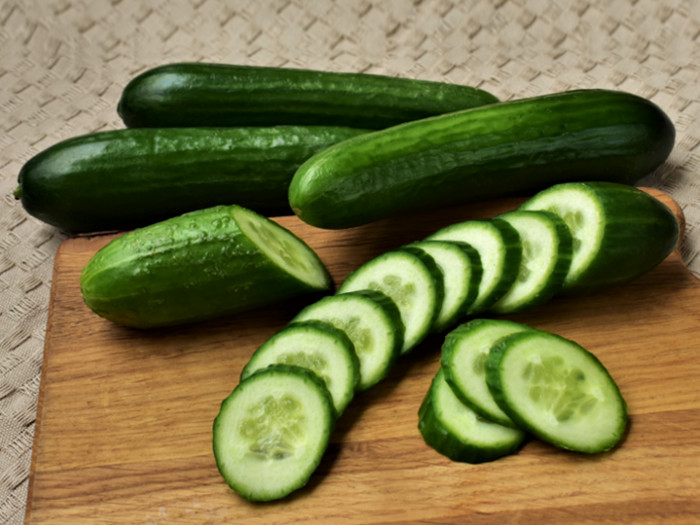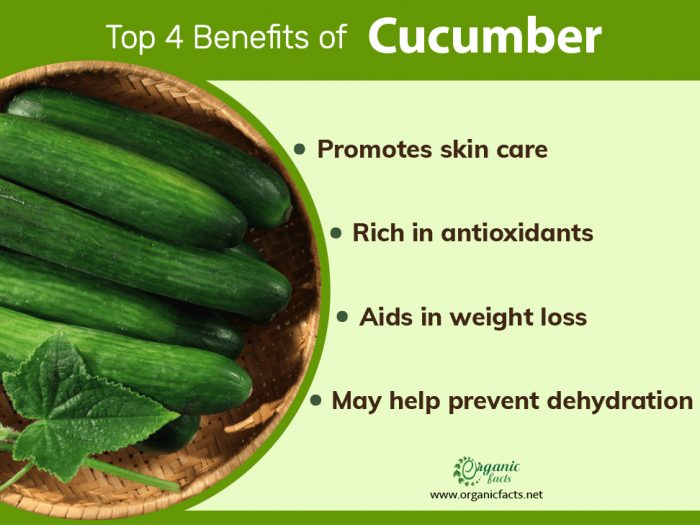Cucumbers can be beneficial for overall health and are particularly enjoyed during the summer months given their high water content. They can also contain important nutrients and antioxidants essential for the human body. Cucumbers’ flesh may also be rich in fiber and a range of minerals.
What is a Cucumber?
Cucumber is a fruit from the Cucurbitaceae family. Scientifically known as Cucumis sativus, it belongs to the same family as zucchini, watermelon, pumpkin, and other types of summer squash. Cucumbers, typically eaten fresh, are called slicing cucumbers. Gherkin cucumbers are specially produced to make pickles (also known as pickled cucumbers). These are much smaller in size than the slicing ones. Slicing cucumbers are available throughout the year, but they are at their best between May and July. [1]
The plant where cucumber grows is a creeping vine that develops these cylindrical, edible fruits throughout the year. Different varieties of cucumber are grown in different regions of the world.

Health benefits of cucumbers are linked to their high antioxidant content. Photo Credit: Shutterstock
Features and Varieties of Cucumbers
You are probably familiar with the phrase “cool as a cucumber”, which directly speaks about the soothing and cooling nature that cucumbers have when eaten. These fruits are grown mainly to be eaten fresh, and in India, you will often find sliced cucumbers being sold on sunny afternoons. They are usually cylindrical and vary in length from about six to nine inches. However, the size of cucumbers vary provided the various cultivating factors. The skin of the cucumbers can vary in color from green to white, and sometimes it may be smooth or ridged depending on the variety. Inside the cucumber skin, you will find pale green flesh that is thick yet aqueous and crispy at the same time. The interior core of cucumber has numerous, edible fleshy seeds. Many cucumber varieties are also grown in greenhouses; they are seedless with thinner skin and a longer length, usually between 12 and 20 inches. Often known as “burpless”, this variety of cucumber is bought by a majority, since it is easier to digest than the other kinds of cucumbers. [2]
| Serving Size : | |
|---|---|
| Nutrient | Value |
| Water [g] | 95.23 |
| Energy | 15 |
| Energy [kJ] | 65 |
| Protein [g] | 0.65 |
| Total lipid (fat) [g] | 0.11 |
| Ash [g] | 0.38 |
| Carbohydrate, by difference [g] | 3.63 |
| Fiber, total dietary [g] | 0.5 |
| Sugars, total including NLEA [g] | 1.67 |
| Sucrose [g] | 0.03 |
| Glucose (dextrose) [g] | 0.76 |
| Fructose [g] | 0.87 |
| Maltose [g] | 0.01 |
| Starch [g] | 0.83 |
| Calcium, Ca [mg] | 16 |
| Iron, Fe [mg] | 0.28 |
| Magnesium, Mg [mg] | 13 |
| Phosphorus, P [mg] | 24 |
| Potassium, K [mg] | 147 |
| Sodium, Na [mg] | 2 |
| Zinc, Zn [mg] | 0.2 |
| Copper, Cu [mg] | 0.04 |
| Manganese, Mn [mg] | 0.08 |
| Selenium, Se [µg] | 0.3 |
| Fluoride, F [µg] | 1.3 |
| Vitamin C, total ascorbic acid [mg] | 2.8 |
| Thiamin [mg] | 0.03 |
| Riboflavin [mg] | 0.03 |
| Niacin [mg] | 0.1 |
| Pantothenic acid [mg] | 0.26 |
| Vitamin B-6 [mg] | 0.04 |
| Folate, total [µg] | 7 |
| Folate, food [µg] | 7 |
| Folate, DFE [µg] | 7 |
| Choline, total [mg] | 6 |
| Betaine [mg] | 0.1 |
| Vitamin A, RAE [µg] | 5 |
| Carotene, beta [µg] | 45 |
| Carotene, alpha [µg] | 11 |
| Cryptoxanthin, beta [µg] | 26 |
| Vitamin A, IU [IU] | 105 |
| Lutein + zeaxanthin [µg] | 23 |
| Vitamin E (alpha-tocopherol) [mg] | 0.03 |
| Tocopherol, beta [mg] | 0.01 |
| Tocopherol, gamma [mg] | 0.03 |
| Tocotrienol, alpha [mg] | 0.04 |
| Vitamin K (phylloquinone) [µg] | 16.4 |
| Fatty acids, total saturated [g] | 0.04 |
| 14:0 [g] | 0.01 |
| 16:0 [g] | 0.03 |
| 18:0 [g] | 0.01 |
| Fatty acids, total monounsaturated [g] | 0.01 |
| 18:1 [g] | 0.01 |
| Fatty acids, total polyunsaturated [g] | 0.03 |
| 18:2 [g] | 0.03 |
| 18:3 [g] | 0.01 |
| Phytosterols [mg] | 14 |
| Tryptophan [g] | 0.01 |
| Threonine [g] | 0.02 |
| Isoleucine [g] | 0.02 |
| Leucine [g] | 0.03 |
| Lysine [g] | 0.03 |
| Methionine [g] | 0.01 |
| Cystine [g] | 0 |
| Phenylalanine [g] | 0.02 |
| Tyrosine [g] | 0.01 |
| Valine [g] | 0.02 |
| Arginine [g] | 0.04 |
| Histidine [g] | 0.01 |
| Alanine [g] | 0.02 |
| Aspartic acid [g] | 0.04 |
| Glutamic acid [g] | 0.2 |
| Glycine [g] | 0.02 |
| Proline [g] | 0.02 |
| Serine [g] | 0.02 |
| Sources include : USDA [3] | |
Cucumber Nutrition
Cucumbers can be a rich source of antioxidants and various other nutrients, vitamins, minerals, energy, and water. According to the USDA National Nutrient Database, cucumbers may be a good source of potassium, phosphorus, vitamin C, and K. They may also provide small amounts of iron, sodium, and B-vitamins (riboflavin, niacin, and vitamin B-6). [4]
Health Benefits of Cucumbers
Cucumbers may help in improving skin, managing diabetes, managing blood pressure, and more. Let us take a look at the health benefits below.
May be Rich in Antioxidants
Cucumbers, when paired with processed or high-sugar foods, may exhibit antioxidant properties. A study involving 30 older adults showcased the antioxidant potential of cucumber by supplementing their diet with cucumber powder for 30 days. The results indicated a notable increase in several antioxidant activity markers, enhancing the overall antioxidant status. [5]
Furthermore, a separate test-tube study unveiled that cucumbers harbor flavonoids and tannins, two compound groups proficient in neutralizing harmful free radicals. It’s pertinent to mention, however, that the cucumber powder utilized in the study likely held a higher antioxidant concentration than a standard cucumber serving. [6]
May Aid in Diabetes Management
Research suggests that cucumbers might have properties beneficial for managing diabetes. A study published in the journal Bioimpacts highlighted the anti-hyperglycemic effect of cucumbers, indicating their potential in glucose control for individuals with diabetes due to a hormone they contain, essential for insulin production by beta cells. [7]
In an animal study, diabetes was induced in mice, which were then supplemented with cucumber peel extract. Remarkably, the cucumber peel reversed most diabetes-associated changes and led to a decrease in blood sugar levels. Moreover, a test-tube study demonstrated that cucumbers might be effective in reducing oxidative stress, thereby potentially preventing diabetes-related complications. [8] [9]
Cucumbers’ carbohydrate content and its impact on the body are gauged by the Glycemic Index (GI), which measures how carbohydrates affect glucose (or blood sugar) levels. With a GI of zero, cucumbers may be a favorable choice for individuals with diabetes, helping to maintain balanced glucose levels. [10]
However, it’s important to note that the existing evidence primarily stems from test-tube and animal studies. More research is necessary to understand fully how cucumbers might influence blood sugar levels in humans.
May Help In Skin Care
Cucumbers can be rich in silica, which is an essential component that can aid in developing strong and healthy connective tissues in the muscles, ligaments, tendons, cartilage, and bones. Doctors often recommend cucumber juice because of the silica content for healthier and brighter skin. Additionally, research in the journal Nutrition Review highlights the importance of fluids and hydration for skin health. Cucumber’s high water content can make it naturally hydrating. [11] [12]
The extract of cucumbers may often be used topically for treating various types of skin ailments like sunburn and under-eye swelling, due to its rich antioxidant content. It may also be recommended to assist in the treatment of other skin ailments like psoriasis, eczema, and acne. [13]
Potential in Blood Pressure Management
The DASH (Dietary Approaches to Stop Hypertension) diet, rooted in research from the United States National Institute of Health, has been recognized for its potential in lowering blood pressure. It emphasizes the consumption of foods rich in magnesium, potassium, and fiber. Notably, cucumbers are mentioned within the potassium food group in this research, hinting at their possible role in blood pressure regulation. [14]
In a separate study, a quantitative approach was employed to assess the impact of cucumbers on hypertensive individuals aged 40-60. Utilizing a simple random sampling technique for participant selection, each individual was administered 100 grams of cucumber daily over a two-week period. The findings suggest that cucumber consumption was effective in managing blood pressure levels, particularly diastolic blood pressure, thereby aiding in averting complications associated with hypertension. [15]
May Aid in Constipation Relief
Cucumbers, with their ideal mix of fiber and water, can be a refreshing remedy for constipation. Incorporating a cucumber-rich salad into your routine may significantly bolster your fiber intake, aiding in softening your stool. Additionally, cucumber seeds are reputed for their cooling effects on the body, which may further alleviate constipation risks. [16]
Specifically, cucumbers contain pectin, a type of soluble fiber, known to enhance bowel movement frequency. A study involving 80 participants supplementing with pectin revealed that pectin not only accelerated the activity of intestinal muscles but also nourished the beneficial gut bacteria, thereby promoting digestive health. [17]
Through these mechanisms, cucumbers may offer a natural, hydrating solution to prevent constipation and support a healthy digestive tract.
Cucumber Recipes
Cucumbers can be cut into various shapes and sizes; they can be sliced, diced or cut into sticks. Cucumber seeds are edible and nutritious, but some people prefer not to eat them. Those that wish to avoid the seeds, can cut cucumbers lengthwise, and use the tip of a spoon to gently scoop the seeds. Cucumbers are commonly used in several recipes. Let us see how.
Cucumber sandwich: The simplest and tastiest way to add cucumbers to your diet is by adding them in between bread. Check out our cucumber sandwich recipe here – Classic Cucumber Sandwich Recipe.
Regular cucumber salad: You can use half-inch thick cucumber slices and serve them with chopped vegetable salads. Cut cucumbers into a dice shape, mix them with sugar snap peas, and mint leaves, and pour rice wine vinaigrette into the mixture.
Cucumber and watermelon salad: Cut the watermelon and cucumber into bite-sized cubes and garnish them with honey, olive oil, and more. Click here for the full recipe – A Step By Step Guide To Make Watermelon And Cucumber Salad.
Cucumber water: Drinking cucumber water is a good way to keep yourself hydrated and improve your skin health. Look at how to make it here – Cucumber Water Recipe: The Popular Detox
Cucumber puree: You can also make an excellent purée with cucumbers, tomatoes, green peppers, and onions. Add salt and pepper for some extra flavor. Cucumbers give a fresh taste to tuna fish or chicken salad preparations.
Buying & Storage
Cucumbers can be very sensitive to heat, so aim to select the ones that are displayed in the refrigerated cases in the stores. Squeeze them for firmness (they should be) and check that the color is a bright medium to dark green. Avoid the yellow, puffy cucumbers that have water-soaked areas or wrinkled tips. You will find fewer seeds in the thinner cucumbers.
Storing cucumbers in the refrigerator can help retain their freshness for a longer time. If the entire fruit is not used in one meal, then wrap the remainder tightly in plastic or place it in a closed container so that it does not dry out. Try to eat cucumbers within one or two days of buying them or else they will become limp, especially if kept for more than a week. If you’re trying to figure how to store cucumbers for a longer shelf life, head over to our article on the same which gives out a detailed guide.

